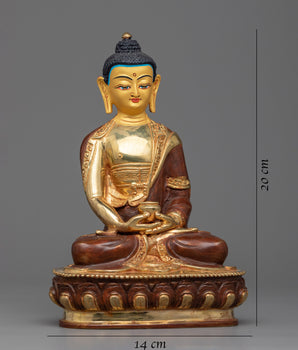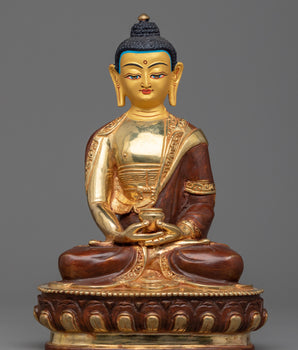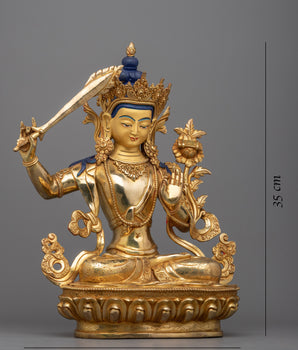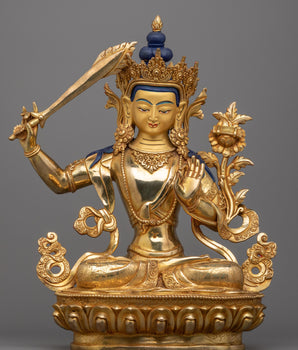Saraswati Across Faiths: Exploring Her Divine Role in Hindu and Buddhist Mythology
Saraswati, The respected goddess continues to have a significant influence across Hindu and Buddhist religious traditions because she represents knowledge, wisdom, and learning. In ancient Hindu texts, Saraswati first appeared as spiritual wisdom along with artistic excellence and eloquence, which showed humans how to achieve both learning and creative success. During centuries, she grew in significance beyond Hinduism to become Buddha mythology's core part in both the Mahayana and Vajrayana traditions. Through these worship traditions, she emerges as a divine protector of dharma, sending spiritual students toward enlightenment and clear communication.
The Hindu and Buddhist ways of understanding Saraswati are different in many ways. This is because their symbols have different meanings, they play different roles, and they are based on different cultural and historical periods. People who follow both the Hindu and Buddhist paths see Saraswati as a goddess of learning, but their artistic representations and functional definitions of her teachings stress different ideas about what wisdom means for people. This blog examines the unique patterns that emerge from these two rich traditions through their understanding, visual representation, and festivals celebrating Saraswati.
Hindu Saraswati: The Goddess of Knowledge and Arts

In the pantheon of Hindu deities, she remains one of the oldest figures, embodying wisdom alongside knowledge and artistic skills. You can find her origins in the Rigveda, dating from 1500 BCE, because her earliest form personified the Saraswati River that supported ancient Indian civilization through sacred waters. History shows that when the holy River diminished in importance, She evolved from her river deity status into a spiritual force that served as a central element of Hindu culture and intellectual and creative power.
According to Hindu tradition, she holds two roles as the deity consorting with Brahma while serving as his parallel representation since she embodies the complete body of knowledge needed for the cultivation of the cosmos. In most depictions, the deity sits on a lotus or swan, which portrays her nature as wise and pure. She carries religious items such as the veena (music), a book (learning), and a rosary (spirituality). In Hindu traditional perspective, the deity functions as a timeless role model to inspire learning and creativity.
Buddhist Saraswati: Guardian of Dharma

Buddhist mythology reveres her as the Guardian of Dharma, embodying wisdom, eloquence, and learning. Known as vajrasravani in Vajrayana Buddhism, she aids in the comprehension and spread of sacred teachings. Unlike her Hindu counterpart, Buddhist Yanchenma emphasizes the spiritual journey toward enlightenment, supporting practitioners in mastering meditation, scriptures, and mantras. Often depicted in a serene meditative posture, holding prayer beads or a lotus, she symbolizes clarity of thought and spiritual purity. Worshipped by monks and scholars, she removes obstacles to understanding, ensuring the dharma's preservation and propagation across generations and cultures. Her essence fosters wisdom and enlightenment.
The 14th-century founder of the Gelug school of Tibetan Buddhism, Je Tsongkhapa, was a Tibetan teacher who also worshipped Yanchenma as his own yidam, or meditational deity. Drawing from his pure vision of her, he composed the exquisite devotional poem "Prayer to Yangchenma." During his years of contemplation and study, she is believed to have frequently traveled to see Je Tsongkhapa, offering guidance and motivation.
Iconography: How Saraswati is Depicted
The Hindu religious aesthetic of Saraswati shows her as a calm and composed being, which represents purity alongside intelligence and jurisprudence. The peaceful behavior of this figure shows her connection to both higher understanding and divine clarity. White garments on the deity represent purity alongside material detachment, so she often appears on lotuses or swan seats. These elements represent enlightenment, self-awareness, and the ability to discriminate between right and wrong. Common elements of her iconography include:
Hindu Saraswati: The Embodiment of Purity and Grace
-
Seated on a Lotus or Swan: She is often shown seated on a white lotus or riding a swan. The lotus represents purity, while the swan symbolizes discernment—the ability to separate the good from the bad, or truth from falsehood.
-
Attributes: She carries a veena (a stringed musical instrument), representing mastery over the arts; a book symbolizing knowledge; a rosary signifying spirituality; and a pot of water symbolizing creativity and life.
-
White Attire: Her white clothing reflects her association with purity, wisdom, and light.
Buddhist Saraswati: The Melody Goddess of Speech
In Buddhist mythology, Saraswati retains her serene and graceful nature but is adapted to the Buddhist context. Her iconography often includes:
-
Seated on a Lotus: Like her Hindu counterpart, the lotus signifies purity and spiritual awakening.
-
Musical Instrument: She is frequently shown holding a lute or veena, symbolizing harmony and the eloquence needed for effective teaching of dharma.
-
Buddhist Symbols: Instead of the Hindu rosary or pot, Buddhist Yanchenma hold texts, prayer beads, or other items representing Buddhist teachings.
-
Regional Variations: In Tibetan Buddhism, Saraswati (known as Yangchenm) may appear adorned with traditional Tibetan attire and symbols, emphasizing her role as a protector of Buddhist teachings.
Role and Significance in Hindu and Buddhist Traditions
Hindu Saraswati’s role centers around fostering intellectual and cultural pursuits. She is the goddess of wisdom, knowledge, and the arts, guiding individuals toward enlightenment through learning and creativity.
Some key aspects of her significance include her influence on education and scholarship, her connection to music and the arts as a source of inspiration, and her symbolic representation of purity and knowledge, guiding humanity toward higher understanding and inner wisdom. She remains a timeless symbol of intellectual and cultural enrichment in Hindu tradition. Some key aspects of her significance include:
Saraswati in Buddhist Mythology
In Buddhism, Saraswati holds a distinct yet equally vital role compared to her Hindu origins. She is venerated as a guardian of wisdom, eloquence, and dharma (the teachings of Buddhism), playing a crucial role in the spiritual lives of practitioners. the deity is seen as a divine figure who aids in the mastery of Buddhist scriptures and the propagation of knowledge, ensuring the clarity and precision of speech are essential for teaching and spreading the dharma. Her presence is invoked to dispel ignorance, foster understanding, and guide individuals along the path to enlightenment.
Hindu Saraswati: Knowledge for Creation and Liberation

As the Hindu goddess Saraswati blesses us with intellectual energy alongside creative power and spiritual enlightenment, we can reach our worldly objectives and advance towards spiritual growth. She showcases the vital amalgamation between intelligence and proper wisdom and creative insights. These essential elements help people deliver academic success as well as reach personal enlightenment. Saraswati, as the goddess of learning, provides inspiration to her followers through truth discovery, intellect refinement and creative empowerment in every life dimension. Through her peaceful demeanor, She illustrates knowledge's powerful ability to improve both physical accomplishments and mystical enlightenment for human beings. Her philosophy emphasizes the importance of:
-
Education and Arts: As an eternal muse of both education and creativity,, Saraswati empowers the human journey toward knowledge and cultural development that drives societal advancement and cultural development. Example wisdom and creative force she inspires students to advance all types of knowledge, including scientific and philosophical learning alongside literary and artistic pursuits and musical understanding.
-
Balance of Material and Spiritual: While Saraswati is deeply associated with fostering intellectual growth and artistic expression, her ultimate goal transcends the material and intellectual realms. She seeks to guide individuals toward moksha, the ultimate liberation from the cycle of birth and rebirth. In this context, She represents the harmonious integration of worldly knowledge with spiritual wisdom, encouraging individuals to use their learning and creativity as tools for self-realization and enlightenment.
Buddhist Saraswati: Wisdom for Enlightenment
Buddhist tradition transforms Saraswati's mission from conventional learning to underline spiritual wisdom because it serves as an indispensable instrument toward enlightenment. The Buddhists venerate Yanchenma as a protective entity of dharma who also helps scholars understand Buddha's teachings and communicate them to others. Through her role, She showcases the way wisdom transforms ignorance while leading people toward spiritual enlightenment. Key aspects of her philosophy include:
-
Guidance in Dharma: Saraswati plays a vital role in helping practitioners overcome ignorance, which is considered one of the primary obstacles to spiritual growth and enlightenment. Through her association with wisdom, knowledge, and eloquence, she empowers individuals to dispel the darkness of ignorance and develop a deeper understanding of the true nature of reality.
-
Clarity in Communication: Her association with speech and eloquence underscores the profound importance of effectively communicating wisdom and knowledge to others. In both Hindu and Buddhist traditions, She is revered as the embodiment of articulate expression, emphasizing the role of clear and thoughtful communication in spreading dharma, or righteous teachings. Her connection to eloquence highlights how the power of words can inspire, educate, and guide individuals on the path of spiritual and intellectual growth.
-
Liberation Through Wisdom: Unlike Hinduism’s broader focus on intellectual, artistic, and cultural pursuits, Buddhist Saraswati is more specifically concerned with guiding individuals on the spiritual path toward liberation, or nirvana. In the Buddhist context, she serves as a protector of dharma (Buddhist teachings) and an embodiment of wisdom and eloquence, aiding practitioners in overcoming ignorance and gaining clarity in their spiritual journey.
Festivals and Worship

Vaneration of Hindu
The veneration of Hindu Saraswati is a deeply ingrained tradition that celebrates wisdom, knowledge, and creativity. She is revered as the goddess of learning, music, arts, and eloquence and is seen as the ultimate source of intellectual and creative energy. Her worship is especially significant among students, scholars, and artists, who seek her blessings to excel in their pursuits. is depicted as a serene figure dressed in white, symbolizing purity and clarity of thought, She seated on a lotus or swan, which represent wisdom and discernment. Her attributes include a veena (musical instrument), a book (symbolizing the Vedas and knowledge), a rosary (spiritual wisdom), and a pot of water (creativity and life).
The most prominent celebration of Saraswati is Vasant Panchami, a festival marking the arrival of spring and dedicated to the goddess. On this day, devotees, particularly students, wear yellow, offer prayers, and keep their books and instruments near her idol, symbolizing her blessing. Saraswati’s veneration highlights the Hindu emphasis on education, cultural refinement, and the pursuit of both worldly knowledge and spiritual growth.
Vaneration of Buddhism
In Buddhism, festivals and worship centered around the deity are particularly prominent in Mahayana and Vajrayana traditions, especially in regions like Tibet, Nepal, and Bhutan. While Saraswati’s origins lie in Hinduism, she was adopted into the Buddhist pantheon and revered as a bodhisattva, or goddess of wisdom, eloquence, and the arts. Her worship reflects Buddhist ideals, emphasizing the pursuit of wisdom and clarity to aid in spiritual growth and the spread of dharma.
She is often invoked during rituals focused on learning, scholarship, and the mastery of Buddhist texts. Monks, scholars, and practitioners seek her blessings for clarity of speech, eloquence in teaching, and insight in understanding complex teachings. In Vajrayana Buddhism, Yanchenma is venerated as a protector of dharma, ensuring the preservation and accurate transmission of Buddhist teachings.
Festivals dedicated to the deity are celebrated in tandem with Buddhist traditions, particularly during important ceremonies associated with education or spiritual initiation. For instance, in Tibetan Buddhism, She is honored before examinations or important debates, where her guidance is sought for intellectual clarity and precision.
Cultural Adaptations and Regional Variations

Saraswati, as a deity, has transcended her origins in Hindu mythology to be embraced across various cultures and regions, resulting in unique adaptations and variations in her representation and role. Her evolution reflects the interplay of religious, cultural, and historical factors, with each tradition shaping her identity to align with its values and practices.
In Hinduism, She is widely worshipped across India as the goddess of wisdom, knowledge, and arts. Her depiction—dressed in white, seated on a swan or lotus, and holding a veena and scriptures—remains consistent. However, regional variations exist in rituals and festivals. For instance, during Vasant Panchami, celebrated differently in North and South India, her blessings are sought for academic success and artistic inspiration.
In Buddhism, particularly Mahayana and Vajrayana traditions, Saraswati was adopted as a protector of dharma and spiritual learning. Known as Yangchenma in Tibetan Buddhism, she is venerated for her eloquence and guidance toward enlightenment. Tibetan depictions often merge her attributes with local influences, such as prayer beads or Buddhist texts.
In Southeast Asia, She has distinct cultural roles. In Bali, Indonesia, she is honored on Hari Raya Saraswati, where books and scriptures are blessed. These regional adaptations showcase her enduring relevance and universal appeal across diverse traditions.
Key Differences Between Saraswati in Hindu and Buddhist Mythologies
|
Aspect |
Hindu Saraswati |
Buddhist Saraswati |
|
Role |
Goddess of knowledge, arts, and learning |
Protector of dharma, wisdom, and eloquence |
|
Iconography |
Veena, swan, books, white garments |
Prayer beads, lotus, meditative posture |
|
Philosophical Focus |
Intellectual and creative pursuits |
Enlightenment and the spread of dharma |
|
Worship |
Vasant Panchami, rituals in schools and homes |
Mantras, meditation practices in Vajrayana Buddhism |
|
Geographic Spread |
Predominantly India |
Nepal, Tibet, China, Japan |
Conclusion
The figure of Saraswati bridges the cultural and religious traditions of Hinduism and Buddhism, showcasing the shared values of knowledge and wisdom. While her role in Hindu mythology emphasizes intellectual and creative achievements, her Buddhist counterpart is more focused on spiritual wisdom and the dissemination of dharma. Understanding these differences not only enriches our appreciation of her significance but also highlights the interconnectedness of these ancient traditions.
Both versions of Saraswati inspire humanity to pursue wisdom and enlightenment, making her a timeless symbol in an ever-changing world.














